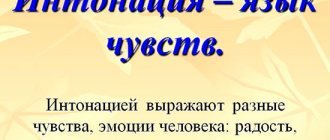Updated September 18: 166,449 Author: Dmitry Petrov
Hello, dear readers of the KtoNaNovenkogo.ru blog. We have all heard about the interpretation of an actor's role on stage or a piece of music by a pianist. It seems that this word is associated primarily with art and has nothing to do with everyday life.
Meanwhile, each of us constantly interprets , because this process is one of the stages of learning about the world around us.
So, let's understand what interpretation is, how it manifests itself in different areas of human life, and how the meaning of a word varies depending on the field of application.
Definition of the word “Interpretation” according to TSB:
Interpretation - Interpretation (lat. interpretatio) interpretation, explanation, clarification. 1) In the literal sense, the term “I.” used in jurisprudence (for example, the interpretation of a law by a lawyer or a judge is a “translation” of “special” expressions in which this or that article of the code is formulated into “common” language, as well as recommendations for its application), art (I. roles an actor or a musical work by a pianist - an individual interpretation by the performer of the work being performed, which is not, generally speaking, uniquely determined by the author’s intention) and in other areas of human activity. 2) I. in mathematics, logic, methodology of science, theory of knowledge - a set of meanings (meanings) attached in one way or another to elements (expressions, formulas, symbols, etc.) of any natural science or abstract-deductive theory (in In the same cases when the elements of this theory themselves are subjected to such “interpretation,” they also speak of the I. of symbols, formulas, etc.). The concept of "I." has great epistemological significance: it plays an important role in comparing scientific theories with the areas they describe, in describing different ways of constructing a theory, and in characterizing changes in the relationship between them in the course of the development of knowledge. Since each natural science theory is conceived and constructed to describe a certain area of real reality, this reality serves as its (theory’s) “natural” information. But such “implicit” information is not the only one possible even for meaningful theories of classical physics and mathematics. Thus, from the fact of isomorphism of mechanical and electrical oscillatory systems described by the same differential equations, it immediately follows that for such equations at least two different Is are possible. This applies to an even greater extent to abstract-deductive logical-mathematical theories, admitting not only different, but also non-isomorphic I. It is generally difficult to talk about their “natural” I. Abstract-deductive theories can do without “translating” their concepts into “physical language”. For example, regardless of any physical geometry, the concepts of Lobachevsky geometry can be interpreted in terms of Euclidean geometry (see Lobachevsky geometry). The discovery of the possibility of mutual interpretability of various deductive theories played a huge role both in the development of the deductive sciences themselves (especially as a tool for proving their relative consistency) and in the formation of modern epistemological concepts associated with them. See Axiomatic method, Logic, Logical semantics, Model. Lit.: Hilbert D., Foundations of Geometry, trans. from German, M.-L., 1948, ch. 2, § 9. Kleene S.K., Introduction to Metamathematics, trans. from English, M., 1957, ch. 3, § 15. A. Church, Introduction to Mathematical Logic, vol. 1, trans. from English, M., 1960, Introduction, § 07. Frenkel A., Bar-Hillel I., Foundations of set theory, trans. from English, M., 1966, ch. 5, § 3. Yu. A. Gastev. Interpretation of programming languages, one of the methods for implementing programming languages on electronic computers (computers). In I., each elementary action in a language corresponds, as a rule, to its own program that implements this action, and the entire process of solving a problem is a computer simulation of the corresponding algorithm written in this language. With I., the speed of solving problems is usually much lower than with other methods, but I. is easier to implement on a computer, and in many cases (for example, when simulating the operation of one computer on another) it turns out to be the only suitable one.
Article on the topic: “Interpretation of lyrical works”
Interpretation of lyrical works
Let's consider this new genre in teaching literature. This is how the Literary Encyclopedic Dictionary interprets the concept of “interpretation”: interpretation (from the Latin interpretatio - interpretation, explanation), interpretation of a literary work, comprehension of its meaning, ideas, concepts. Interpretation is carried out as a redesign of artistic content, that is, through its translation into a conceptual-logical (literary criticism and the main genres of literary criticism), lyrical-journalistic (essay) or into another artistic language (graphics, theater, cinema and other arts).
Interpretation already existed in antiquity; the theoretical foundations of interpretation were developed by interpreters of the Holy Scriptures.
In Russian literary criticism, the term “interpretation” appeared in the 20s, but gained relevance only in the 70s. The interpretation of a work of art inevitably depends on the personality of the researcher; comprehension of the content is accompanied by “spiritual communication” between the reader and the author, while intuition is actively involved and there is an evaluative attitude towards art.
The goal of interpretation is to achieve, based on certain reliable data, an adequate, although always only relatively complete, understanding of the fundamental principles of the text. Ideally, the interpretation of literature is not tendentious knowledge: the interpreter, as it were, moves his soul “inside” the poem and surrenders himself to its power.
Interpretation of a poetic work
- this is not only the analysis itself (problem-thematic, motif-figurative, linguistic), but also the creation of a holistic reader’s concept based on this analysis. Interpretation is finding “one’s own” in “someone else’s” in the process of thoughtful, slow reading, penetration into the figurative world of the work. It should be recalled that the analysis of a poetic work differs significantly from the analysis of a prose text, which is due to the very nature of the lyrics. The main component of a lyric poem is a lyrical image-experience, the embodiment of which is a special poetic language, where all elements of the artistic form acquire significance: graphics, phonetics, vocabulary, poetic syntax, rhythmic and melodic organization. At the same time, we should not forget that a lyrical work “exists” in a literary context, is based on a certain tradition, continues it and at the same time argues with it. Therefore, a comparative analysis of lyric poems is given taking into account the special role of “alien speech”, reminiscences and dialogue with predecessors in the structure of the text.
SCHEME OF ANALYSIS (INTERPRETATION) OF A LYRIC WORK
I Imprint.
1. Author, title, time of writing, history of creation, place in the work, to whom it is dedicated.
2. Information about the literary situation, how the poem was received, what literary movements and trends existed at that time, to which the author belonged.
P. The structure of images and the development of conflict1
1. Topic2 and idea3.
2. Composition4.
3. The movement of thoughts and feelings in a literary text, the development of conflict and plot5 (if any).
4. A system of artistic images, their direct or indirect correlation with a person’s life and his feelings.
5. Traits of a lyrical hero.
Sh. Genre originality (ode, elegy, hymn, romance, invective, ballad, etc.)
IV. Main features of poetic language.
1. Paths and figures (comparisons, epithets, metaphors, personifications...).
2. Allusion, reminiscence (if any).
Allusion
- in fiction, oratory and colloquial speech - one of the stylistic figures: an allusion to a real political, historical or literary fact that is considered generally known. The goal is to evoke certain associations in the reader’s memory and provoke reflection.
Reminiscence
(from Late Latin reminiscentia - memory), in a literary text (primarily poetic) features that suggest a memory of another work... As a conscious device, it is designed for the memory and associative perception of the reader.
3. Language level analysis:
- poetic phonetics (alliteration, sound writing, assonance);
ALLITERATION
- (
from Latin ad - to, with and lit(t)era - letter
) - a type of sound writing: repetition in poetic speech (less often in prose) of the same consonant sounds in order to enhance its expressiveness.
For example: The
hissing of
the
foam
from
the
old
glasses And
the
plume
of
a flame .
ASSONANCE
- (
from the French assonance - consonance
) - One of the types of sound writing: repeated repetition in a poem (less often in prose) of the same vowel sounds, enhancing the expressiveness of artistic speech.
I
wander along
the
noisy
faces , I enter
a
crowded
temple, I sit
among
the
mindless
youths
, I indulge
in
my dreams.
SOUND RECORDING
- a system of means and techniques for the sound organization of a work, allowing the author to create the desired emotional impression at the phonetic (sound) level of speech. For example, thanks to the consistent use of sounds [l], [a], [e], in the lines of the poem “Petersburg”, V. Nabokov conveyed a feeling of lightness, flight: And I hear Pushkin remember // all the winged little things, shades and echoes: “I remember,” he says, “the flying snow, and the Summer Garden, and Olenina’s babbling... One of the stanzas of B. Pasternak’s poem “Snow is falling” is rhythmically and phonetically organized in such a way that you can hear the ticking of a pendulum: The snow is falling, // thick- thick, // In step with him, // in those same feet, // At the same pace, // with that laziness // Or with the same // speed, // Maybe time is passing? B. Pasternak
- poetic vocabulary (synonyms, antonyms, homonyms, historicisms, neologisms...);
- use of the phenomena of morphology and syntax.
V. Rhythm, poetic meter, rhyme.
VI. Features of intonation.
VII. Personal perception of the poem.
1.Perception (first impression).
2.What thoughts, feelings does the sound, color background awaken?
Associations, thoughts, evaluation, interpretation.
Perception
- this is a personal attitude, the response that the work found in the writer, the thoughts and feelings that it evoked. We can also talk about the perception of the poem by the author’s contemporaries, his like-minded people and opponents, critics, literary scholars, composers, artists, etc.
Grade
- these are comments about one or another side of the skill of the author of the poem and judgments about the artistic value of the text under study, about the significance of the work in creativity, literature in general. Assessment also includes the points of view (assessments) of other people. It is obvious that the line between perception and evaluation is fuzzy, and the connection is not very defined.
Fedor Tyutchev
Fountain
| See how the shining fountain swirls like a living cloud; How it burns, how its moist smoke breaks up in the sun. Rising to the sky with a ray, he touched the cherished heights - And again, with fire-colored dust, he was condemned to fall to the ground. O mortal thought water cannon, O inexhaustible water cannon! What incomprehensible law strives for you, troubles you? How greedily you strive for the sky!.. But the invisible hand of fate, Your persistent ray, refracting, Overthrows in spray from the heights. |
Analyze the poem by F.I. Tyutchev “Fountain”, filling in the gaps in the supporting text.
Mastering the content of the poem
The poet addresses (to whom?)
………………………… drawing attention to the picture depicting
(what?)
…………………. A fountain is an architectural structure designed in such a way that ………………….
Tyutchev compares ……………………. with a fountain, saying …………………………………………………………
The law according to which ……………………………………., the poet calls ……………………………………………………….
Human thought, according to Tyutchev, is …………………., but at the same time it is ………………………………………………………
The pathos of a poem can be called (dramatic, tragic, romantic, sublime - underline as appropriate
), because ………………………….
Consider the composition of the poem and rhyme
The poem has ... stanzas, each of which consists of ... verses. The first depicts a fountain, the second - ………………….
Such a composition can be called “mirror” because ………………………………………………….
Rhyme plays an important compositional role in the poem, because it is (paired, cross, ring - underline as necessary
), due to which the effect …………………………………………..
Within each stanza there is a line of “ascent” and “descent”. In the first stanza, on the border of ... and ... verses, in the second - ... and ...
We study the figurative, lexical and grammatical structure of poetic speech
When drawing a fountain, the poet strives for the greatest expressiveness of the picture, for which he uses various visual and expressive means, for example (give the names of the tropes)
…………………………..
The multi-colored rainbow shine of water is depicted using …………………………………………..
To enhance the impression of the picture, the author resorts to repetition……………………………………………………….
The use of three verbs in a row (………………….) gives the description (dynamic, static - underline as necessary
).
In the first four verses the verbs are …………………. species are used in the form ……………………………….. tense. In the next four, these are verbs (gerunds) of ……………………… type, used in ……………….. tense. (This emphasizes that actions are repeated, last in time, are completed - underline what is necessary
.)
Important words…………………. placed at the end of the stanza. They are particularly expressive, since their stylistic coloring is …………..
In the second stanza of the poem, where Tyutchev likens …………………. fountain, the epithets ………………… are especially expressive. This is further enhanced by the fact that they rhyme.
Metaphor “invisibly fatal hand” (maybe, can’t - underline as necessary
) be interpreted literally, since ………………….
The last word in the poem…………………. It already sounded accompanied by the epithet …………………. Now it sounds different because ………………….
Considering poetic syntax
The emotional richness of the poem is enhanced by the use of a variety of syntactic structures. The first four lines, united by a common rhyme, represent (type)
………………….
a sentence with a main sentence consisting of one word - “look”, which contains an appeal and an appeal. The repetition of the conjunction “how” draws attention to the object of the image - the fountain, connecting the verbs “swirling”, “flaming”, “crushing”, which helps make the picture visible. An important stylistic role is played by inversion (examples)
, emphasizing the significance of words whose position in a sentence is unusual.
The second stanza begins with a rhetorical (question, appeal, exclamation - underline as necessary
), the role of which is to strengthen ………………….
Anaphora ( quote
) performs the same role.
This is followed by a rhetorical (question, exclamation - underline) (quote)
, containing repetition ………………….
Antithesis …………………………….. completes the poetic thought.
We observe the metrical, intonation and phonetic aspects of the poem
The poetic meter that Tyutchev uses is ……..foot ………………….
However, there are only... poems in which the rhythmic pattern fully corresponds to the control row. They are located symmetrically in the center of each stanza. Almost all poems contain two-syllable feet without stress (title)
.
They appear in place of words consisting of more than two syllables, or at the junction of words. Syllables are pronounced without stress (faster, slower than stressed - underline what is appropriate
). This diversifies the sound, highlights particularly significant words, and gives excitement and emotionality to the intonation.
In the last two verses there is a rhythmic pattern (same, different - underline as necessary
). This gives the poem harmony, completeness, and grace.
The effect of bright colors in the painting depicting a fountain is reinforced by the corresponding sound instrumentation of the poem. Combinations of voiceless, sonorant and voiced consonants sound varied and bright: cm-tr-bl-kl-pl-dr-vl ( in words
: …………….).
At the beginning of the second stanza, alliteration with “m” is clearly indicated ( in the words
: ………………….).
It seems to return us to the sound line of the first verse, where the same sound phenomenon was observed in the words ………………….
The sound roll-call reinforces the important semantic connection between the words………………….
The alliteration in the last four verses is especially expressive. The sound “r”, menacing, booming, is heard here in combination with the consonants …………………. in words: ………………….
This makes the ending (powerful, calm, tragic, cheerful, emotional, energetic - underline as appropriate
).
We begin to feel (understand) that (write about your impression)
………………….
Analysis of the poem "Fountain"
- The history of the creation of the poem.
The exact time of creation of the poem “Fountain” is unknown (according to some sources it is 1836, according to others - the mid-30s of the 19th century). The decade from the mid-20s to the mid-30s was the heyday of F. I. Tyutchev’s talent. At this time, he created such masterpieces as “Spring Storm”, “Autumn Evening”, “Insomnia”, etc. In those years, the poet was in diplomatic service abroad, in Munich. His close friend I.S. Gagarin, dreaming of introducing the capital's writers to the work of his friend, asks the poet to send a selection of his poems. F. I. Tyutchev soon fulfilled his friend’s request, accompanying the poems with the following letter: “You asked me to send you my scribbling paper... I’m taking this opportunity to get rid of it. Do with it what you want. I have an aversion to old, scribbled paper, especially that written by me. She smells musty to the point of nausea...” The poems were published in Pushkin's magazine Sovremennik in 1836 in issues 3 and 4, signed “F. T.". Instead of 5 or 6 poems, as planned, 24 were published (apparently, Pushkin liked them so much). Among them is the poem “Fountain”.
Tyutchev at this time is 33 years old - the age of Christ, wisdom, divine revelations. Poems written at this time are distinguished by deep content and perfect, harmonious form. Let's try to see this by reflecting on the poem "Fountain". Let me remind you that in our research we rely on the approximate plan for the analysis of a lyrical work that we have previously drawn up and, as usual, we use it creatively, that is, we dwell on the most significant aspects of the study for a given text and carry out the analysis in the order that “prompts” the text itself.
- Verbal drawing, reference to illustrative material (photos of Petrodvorets fountains).
To describe in words what was presented, listening to the poem, I am interested in which lines helped to present this especially clearly. Does the picture created by the imagination coincide with the appearance of the fountains they know (we rely in the conversation on the life experiences of the children and photographs of the fountains of Petrodvorets). Using a dictionary, we find out the meaning of unfamiliar words “water cannon,” “hand,” “spurt,” “sweep,” “mortal.” (1 microgroup).
- Comparative analysis of F. I. Tyutchev’s poem “Fountain” and an excerpt from A. S. Pushkin’s poem “To the Fountain of the Bakhchisarai Palace” ( Appendix 1 ). Research in microgroups followed by collective discussion.
The image of a fountain is often found in Russian poetry. Suffice it to recall A. S. Pushkin’s poem “The Bakhchisarai Fountain” and his poem “The Fountain of the Bakhchisarai Palace”. Let's try to compare an excerpt from this poem with a poem by F.I. Tyutchev. I ask the children to work in pairs and note what is common and different in these texts.
General:
1) mood: admiring the beauty of the fountain is accompanied by sad thoughts (“two roses”, “tears” in Pushkin and, for example, “fall”, “condemned”, “invisibly fatal” in Tyutchev’s text. 2) the epithet “alive”. Why do two poets, without agreeing, use the same epithet? Is it possible to replace a word in these texts? Let’s conduct an experiment and replace “live” with “big”. We note that the rhyme does not suffer, but the use of the word “living” not only makes the artistic image more vivid and visible, but also allows us to draw a parallel with human life. 3) poetic meter - iambic tetrameter, one of the most common meters in Russian poetry of the 19th century (perhaps poets are more interested in the content of the poem rather than the form?)
Differences:
1) in Pushkin the image of the fountain is auditory (“non-silent talk”), and in Tyutchev it is visual (its specificity is set by the first word “look”). 2) the image of a fountain is filled with different content: for Pushkin it is a fountain of tears, a “fountain of love”, a sign of the world of feelings, experiences, the human soul; for Tyutchev, this is a “water cannon of mortal thought,” an image of the mind, human intellect. We note that this is the specificity of the creative manner of F. I. Tyutchev, a poet-thinker, poet-philosopher. This was already noted by his contemporaries. I. S. Turgenev wrote: “Each of his poems began with a thought...”
1) Composition.
The poem is compositionally divided into two parts: the first 8 lines create an image of the continuous movement of water in a fountain, as if illustrating the direct meaning of the word “fountain” - a stream of water shooting upward. In the second part we are talking about thought, the human mind, now the figurative meaning of the word “fountain” is involved - an inexhaustible, abundant flow of something (dictionary entry - on the board). The division into stanzas emphasizes the two-part structure. I inform the children that in some publications the text is not divided into stanzas. Is there any logic to this? Students should notice the inextricable internal connection between two parts of the text: the first is an illustration, a visual picture, the second is a reflection. We assume that comparing the parts may help us understand the idea of the poem.
2) Punctuation.
The second stanza is more emotional. If in the first we are talking about punctuation marks (comma, full stop, dash, semicolon), then the second stanza “presents” us with exclamation marks, question marks and even a special synthetic punctuation mark
(!..). This convinces: the philosophical grain of the poem, its idea must be sought here. Thanks to rhetorical exclamations and a rhetorical question, the second stanza involves the reader in the author's thoughts and experiences, as a result, the reading of the text becomes deeply personal.
3) System of images.
- The title, central image, apparently, was not chosen by chance by the author: better than others, he paints a picture of the eternal, inexorable movement towards a high goal: water - to heaven, human thought - to truth.
- We note that in the first part the figurative system is more figurative, picturesque, and joyful. The color palette is optimistic: “shining”, “flaming”, “sun”, “ray”, “fire-colored”, etc. We draw attention to the amazing epithet “fire-colored”, the author’s discovery.
- In the second part of the poem, the focus is on the image of thought, a living, active principle, striving for the high, the transcendental. The second stanza is filled with more abstract images. It is this stanza, first of all, that is intended to convey the idea of the poem, to become a kind of conclusion from the author’s observations.
- Despite all the contrast, the deepest internal cohesion of the parts is emphasized by the general artistic image of a ray soaring towards the sky. This detail likens thought to a fountain. It is no coincidence that in the last lines these images are combined.
4) Features of vocabulary.
Without the opportunity to engage in a detailed lexical analysis of the text, we focus only on some features of the vocabulary.
- An abundance of words with a high stylistic connotation, including obsolete words. We explain this fact by the author’s appeal to high themes, his attempt to formulate universal, philosophical laws of existence (especially noteworthy is the replacement of the word “fountain” with the synonym “water cannon”)
- The passive participle “condemned”, due to its grammatical form, is permeated with the author’s special pain associated with the understanding of the limitations of the human mind.
5) Organization of artistic space and time.
Both parts of the poem, at first glance, seem to be organized in the same way in this regard: upward movement, and then an inexorable descent downward. In this movement in a circle there is a certain doom, a feeling of the impossibility of breaking out of its limits.
Modeling
.
We analyze models of artistic space created by children for the lesson. We note that the reader’s attentive gaze also reveals that these two circles are not identical. The first depicts the movement of water (this is a narrow, material world), and the second - the circle of thought (the limitless world of spirit). And since the second circle is wider, it means that in this we can see, albeit weak, but still hope that the desire for truth is not a movement in a closed circle doomed by the “hand of the invisible fate”, but an upward movement, in a spiral, that This is slow and difficult, but still an approximation to the truth.
My models are in Appendix 2, 3. I share my little discovery with the children: the letter “f” is a kind of reflection of the composition of the text, another version of its model (in it, in addition to two circles, a rod in the middle, a certain vertical connecting heavenly and earthly). Moreover, this letter somehow magically resembles a fountain (meaning its graphic appearance).
Artistic time in the text changes from the beginning to the end of the poem: in the first stanza it can be defined by the word “now”, in the second - by the word “always” (this word “law” suggests). Thus, we celebrate the expansion of artistic time.
As a result of such observations, we conclude that F.I. Tyutchev, with a certain amount of pessimism, deduces a certain universal law, the law of the inexorable movement of human knowledge forward, upward, towards the truth. In this one can see Tyutchev’s faith in the power of the human mind, the high humanistic meaning of this poem and the poet’s work in general.
6) Phonetic structure of the text.
The phonetic organization of the poem is interesting. Everything that is outside the norm, the usual ratio of vowels and consonants, is curious. Based on this, we draw attention to the following features of the text:
- There are many vowels in the poem. For example, in line 3 there are 14 consonants and 9 vowels, and in verse 6 there are 13 consonants and 9 vowels. As a result, the text, despite the author’s reflections on the limitations of human capabilities, amazes with a sense of freedom, spaciousness and optimism.
- There are a lot of whistling consonants in the text, for example, the sounds “s, s,” occur 19 times. They apparently reflected the earthly, mortal principle. Only in two verses (14 and 15) they are not present (there we are talking about the highest, the divine). But there are a lot of “r”s and “l”s. In this confrontation there are 4 “r” and 4 “l”, the most menacing, alarming, severe and the softest, most affectionate - a manifestation of the climax, the highest point in the development of the lyrical plot. This also reaches the level of philosophy: life is an eternal confrontation, an eternal struggle, an eternal desire for truth and an eternal impossibility of achieving it.
7) Features of rhyme.
By the nature of the rhyme, the poem could consist of 4 quatrains, but the author’s combination of quatrains 1 and 2, 3 and 4 was apparently done intentionally, for compositional reasons: quatrains 1 and 2 depict the movement of water, quatrains 3 and 4 – human thought.
In each quatrain we observe a girded (encompassing) rhyme, i.e. lines 1 and 4, 2 and 3 in the quatrain rhyme. This method of rhyming is rare in Russian literature. This interesting, sophisticated form is harmonious with the content, similar to the movement of a fountain. The expressiveness of the rhyming method is emphasized by the following fact: in each quatrain, lines 2 and 3 end with a soft, delicate feminine clause, and lines 1 and 4 with a masculine clause, which gives each quatrain completeness and completeness. The last stressed syllable in a quatrain is a certain point, a conclusion from what has been said. As a result, the entire poem sounds very convincing, the author’s judgments claim to be true.
 Symbolism.
Symbolism.
In the poem by F.I. Tyutchev there are enough symbolic, polysemantic elements. These are also images-symbols
(a fountain is a symbol of eternal, unstoppable movement, the “invisibly fatal hand” is a symbol of any limits, difficulties on the way to the goal, etc.), and, for example, the number 4, which has found plastic embodiment in various elements of the text. The poem has 4 quatrains, it is written in iambic tetrameter, in the culminating verses 14 and 15 - 4 “r” and 4 “l”, and finally, the image of the fountain (water cannon) itself appears four times (including the name). The symbolism of the four draws us to fundamental, all-encompassing images: 4 cardinal directions, 4 seasons, 4 ends of the cross, 4 stages of human life, etc. Four is a symbol of integrity, organization, perfection, wholeness. Apparently, this reflected the philosophical and religious views of the poet-thinker, who even in his words strived to improve the world.
9) The image of a lyrical hero.
In the poem there emerges the image of a lyrical hero, certainly close to the author. This is a thinker for whom the highest value is the human mind. He admires the greatness of the world, the cosmos, God and mourns the impossibility of man to comprehend all the secrets of existence. At the same time, the leitmotif of the poem becomes the idea of the need to dare, to constantly strive for the sky, the beyond, thereby steadily approaching the truth. The study of other aspects of the poetic text convinces us of this.
The idea of the poem (conclusion based on the results of a heuristic conversation). Summary of the Academic Council.
- O The world is beautiful and amazing.
- O Human thought is not always able to penetrate the secrets of the universe.
- O We must not give up, we must always strive to learn more, to get closer to the truth. This is the acquisition by man of a certain divine essence.
Interpretation of research results
To derive a hypothesis and determine the exact meaning of a phenomenon, research is carried out. They are aimed at studying, identifying patterns, and making accurate forecasts. Thus, hypotheses gradually turn into true knowledge, which is scientifically confirmed. And after each study, an interpretation is carried out, that is, an analysis of the data obtained.
Since there are cases when specially organized conditions lead to a different, unplanned result, numerous studies are carried out here to understand what influences the change in results, which is also interpreted and inferred as true knowledge.
The following types of research are distinguished:
- Genetic – when the evolution of the genetic component is studied over a long period of time.
- Structural – when the structural components of a subject are explained. Long-term observations are made here to detect various changes.
- Functional – when the dynamics of the development of a phenomenon are observed in order to determine connections with the environment, influence, etc.
- Complex - when the subject is studied at various levels.
- Systemic – when individual components that make up a single system are studied.
Pros and cons
What is PDF and how can it be attached to web applications using PHP
The main argument for using the compilation process is speed. The ability to compile any program code into machine code that a PC processor can understand eliminates the use of intermediate code. You can run programs without additional steps, thereby increasing the speed of code processing.
But the biggest disadvantage of compilation is specificity. When you compile a program to run on a specific processor, you create object code that will only run on that processor. If you want the program to run on another machine, you will have to recompile the program for that processor. And recompilation can be quite difficult if the processor has limitations or features that are not inherent in the first one. It can also cause compilation errors.
The main advantage of interpretation is flexibility. Not only can you run an interpreted program on any processor or platform for which the interpreter was compiled. A written interpreter can offer additional flexibility. In some ways, interpreters are easier to understand and write than compilers.
Using an interpreter is easier to add additional functionality, implement things like garbage collectors, rather than extend the language.
Another advantage of interpreters is that they are easier to rewrite or recompile for new platforms.
Writing a compiler for a processor requires adding many functions, or completely reworking it. But once the compiler is written, you can compile a bunch of interpreters and the output is a promising language. There is no need to re-implement the interpreter at the base level for a different processor.
The biggest disadvantage of interpreters is speed. For each program, so many translations and filtering are performed that it slows down the work and interferes with the execution of the program code.
This is a problem for specific real-time applications, such as high-resolution and simulation games. Some interpreters contain components called just-in-time (JIT) compilers. They compile the program immediately before executing it. These are special programs outside the interpreter. But as processors become more powerful, this problem becomes less of an issue.
What it is?
Translated from Latin, the word interpretatio means explanation, interpretation).
This definition of the term gives us an explanatory philosophical dictionary. In humanitarian knowledge, it is used in a meaning close to the word “understanding”
Synonyms for interpretation:
- interpretation;
- a comment;
- clarification of meaning;
- transcript.
Perceiving information from the environment, each person analyzes it in his own way. Of course, there are ideas and concepts that are common to everyone, but since all people have individual thinking, the same phenomena are interpreted differently.
Often this process occurs unconsciously (at the level of sensations, moral norms, rules of behavior laid down in childhood, and worldview). When a person uses his knowledge to decipher any data, the interpretation is directional in nature (for example, translations of texts from foreign or complex scientific languages into a native or easier to understand language).
You can interpret anything: information, events, dreams, laws, musical and literary works, films and even analyses.
general information
The phrase “text interpretation” evokes rather contradictory associations. For some, it is associated with something very complex, boring, and certainly scientific; most likely, the first part of the term is to blame. The word “interpretation” is interpreted as the work of thinking, consisting in deciphering the meaning of a phenomenon for its understanding and subsequent work with it, and if we interpret this long and complex sentence into understandable language, then we can say that interpretation is the adaptation of the text for one’s own perception and understanding. In principle, everything is not so complicated; it is enough to understand the principle of working with text, not only written, but also oral, and also to realize the importance of individuality and subjectivity in the perception of information.
Interpretation of this in literature
In literature, interpretation of a text is needed in order to interpret its meaning as intended by the author, clarify hidden connections and describe their meaning.
The same text can be interpreted many, many times in different ways, so objectivity in interpretation is not very significant. The interpretation of a work is greatly influenced by the personality of the interpreter; the entire significance of the interpretation may depend on his prejudices and attitudes. The era to which it belongs also matters.
Because of this, the interpretation of the text is always relative.
Examples of text interpretation: the person who interpreted the text lived in the old century, and he was influenced by social and historical events that left their mark on the very understanding of the text; contemporaries look at the same work in a completely different way; they interpret it through their understanding in the modern sense. They could see a meaning in the text that their predecessor had no idea about, but at the same time they could not fully understand his thoughts. In what historical era, no matter what influence the person interpreting was under, the true meaning that was intended by the author can never be comprehended by anyone.
Interpretation of literature has its own characteristics in different historical periods.
In antiquity, interpretation was used to reveal the meanings of allegories and metaphors that permeate literary works. Not only the text in general was interpreted, but also the connections between elements in the text.
In the Middle Ages, interpretation, as a fundamental method for understanding a text, was mainly applied to the interpretation of Holy Scripture and biblical texts.
In the modern era, the meaning of interpretation became even broader, it acquired a more philosophical direction and began to be applied in different directions.
Interpretation is the awareness of the underlying meaning in the author’s work, where it is the main source of the idea of the given text. And in order to better understand what the author meant, it is necessary to know his personality. Studying the author's biography will make it possible to feel what influence he was under, what might have bothered him at that time, such a transfer contributes to high-quality interpretation.
Interpretation also began to be understood as deciphering a text code, which is represented by the structural components of the text. In this case, the meaning does not come from the personality of the author and his attitudes. The text is quite self-sufficient and has an objective structural character; these characteristics contain real meaning.
Interpretation in the postmodern approach was understood as a technique through which a literary text is filled with meaning. In this approach, the work itself is not intended by the author; its meaning is not determined by any structural components or characteristics of the text. The meaning of a work is understood in the process of reading, that is, the reader himself fills the text with a meaning that he personally understands through the prism of his personal characteristics and life experiences, which influence understanding and awareness of the meaning. But this meaning is true only at the moment when the reading process occurs, because, in essence, there is no single meaning in the work if it changes from one reader to another. Coming from all such different meanings of interpretation, it is difficult to reduce it to a single scientific meaning and create a definition.
Interpretation is an individual perception of a literary work, providing it with meaning, thanks to the intellectual capabilities of what is being read. Sometimes one text is so often interpreted in many ways that, on the one hand, it interferes with its perception, since some thoughts of previous interpreters have betrayed their influence, but on the other hand, it means the richness of the text, its interest and meaning.
Based on the above, the concept of interpretation as a scientific method is not defined in the literature. It is simply understood as a way through which meaning is interpreted through the interpreter’s own value system, who himself picks the field of interpretation.
We are on Telegram! Subscribe and be the first to know about new publications!
Prose of life
Interpreting a prose text is fraught with the same difficulties as a poetic text. Again, different, individual interpretations of individual concepts, again an incomplete understanding of words - the only thing that makes it easier is that in prose there are usually fewer means of artistic expression, and, as a rule, they do not make it difficult to understand the text.
In principle, for successful interpretation, you can engage in precise “translation”, if you can call this phenomenon that way - clearly check the lexical meaning of each word of the proposed fragment, select the optimal combinations for expressing thoughts - practically rewrite the text completely based on synonymous constructions. Or you can use a technique that linguists call a linguistic guess: in this case, it is not necessary to know the exact meaning of each word, it becomes clear from the situation.
The second method demonstrates a fairly high level of language proficiency, but at the same time does not provide one hundred percent accuracy of interpretation. The advantages of this method include the fact that the same word can have a number of lexical meanings, different in tone (for example, “ambitiousness” can be both a positive and negative quality depending on the context), and linguistic guesswork makes it possible to avoid the monotonous search for the correct meaning, simply demonstrating the necessary semantic nuance in the text.
Step-by-step instructions for performing interpretation
1. Study well the work whose interpretation you need to write. As you study, record more important and interesting points in the test that can help you with your analysis. Quotes from the work of art must be included in the interpretation, therefore, in order not to waste time on a repeated search, it is better to record them immediately.
2. Therefore, you need to build a visual plan for your work, which will include the theme of the text, the writer’s idea, the idiostyle features of the writer, the characteristics of the images of the main characters and compositional features. Due to the genre specificity, parts of the plan may be subject to change, decrease in volume or be replaced by others. For example, if you need to interpret a text about nature, then, of course, the characterization of the images of the main characters will be absent in your plan.
3.Next, carefully check each aspect of the analysis. Try to split your analysis into parts as little as possible. Do not make sharp transitions from topic to idea, from idea to composition features, and so on, you should have smooth logical transitions.
4. When highlighting a topic, do not make hasty and unambiguous conclusions. Think carefully, justify your point of view, because you can make a very big mistake. After all, fiction deals with many different topics that are very important for a particular time.
5. Also, a difficult task will be to determine the author’s intention. It happens that famous literary scholars who have devoted many years to studying the work of a writer cannot come to the same opinion regarding the idea of a particular work. Most often this occurs due to the writer’s lifetime contradictory messages and ambiguous interpretation of the literary work.
6. If your work is related to such a controversial text, then it is better to first note the views and words of the author on this issue, and then give your personal opinion.
7. To judge the features of a composition, it is first necessary to identify the standard structure of the composition, which should include: exposition, development of actions, plot, denouement, climax. Also, an epilogue and a prologue will be optional, but very significant elements.
8. You can rely on the absence or presence of a specific component of the composition. You can also focus on the role each part plays.
9. To describe the characteristics of the main characters, you can rely on the principle of their complete difference from each other or any similarity (antihero - hero).
10
When describing the idiostyle features of the author, you can pay attention to the specific vocabulary that he used, intentionally complex or, quite the opposite, simple syntactic structure, reference to folklore, and so on. Your goal is to display all the individuality and peculiarity of the creative manners of a particular writer
Interpretation of this in psychology
Interpretation in psychology is a procedure through which a psychologist (in psychological counseling) explains to the client the meaning of his actions.
Examples of interpretation in psychoanalysis: interpretation of dreams, associations and deep human instincts. The dream definitely makes sense, it can be explained if you trace the person’s current activities, experiences and feelings. All these relationships can be displayed in a symbolic image in a dream, and only through correct interpretation can their deeper meaning be understood. Associations that are caused by sleep are also interpreted. You can check the correctness of the analyst’s interpretation of the dream if a certain reaction occurs in response, corresponding to the interpretation of the psychologist’s words.
Interpretation is especially relevant in psychological studies, where there is complexity in the meaning of a phenomenon. It is based on the exchange of values, meanings and information between sciences, concepts and theories, the use of different types of knowledge, different forms of ideas about the phenomenon under study and its development.
When using empirical data, provisions, patterns, knowledge taken from other sciences, it is necessary to explain their meaning, and also to identify the psychological meaning of this provision. Comparing these two obtained meanings allows us to correctly use the conclusions in psychology and also other sciences. Sometimes it happens that the process of exchanging conclusions and provisions between sciences is very complex, since there are categories that are called the same, but each science gives them different meanings, because of this the true meaning of the concept is lost. Also, the interpreted object already has its primary meaning, and the imposition of another or some meanings on it greatly complicates its perception.
In psychological and pedagogical research, knowledge acquired from other sciences and used in the interpretation of a phenomenon should be of a more humanitarian nature for its better perception and interpretation of their true meaning, which is of immediate significance.
In psychological interpretation, it is necessary to constantly compare scientific knowledge and the empirical experience of each person. Scientific laws cannot fully reveal the full meaning of the phenomenon under study without taking into account the subjective influence of a person.
The use of tests by psychologists in individual counseling is subject to criticism, precisely because the interpretation that is the only one in the test may not fully express all the characteristics of a person.
The interpretation of test results must be clear to the client; for this purpose, one of the interpretation methods can be used.
Descriptive interpretation of test results describes information regarding the current state of the test taker.
Genetic interpretation explains how the subject arrived at the current level of development.
Predictive interpretation focuses on predicting the future.
The evaluative interpretation contains the interpreter's recommendations.
In psychology, the interpretation of a drawing is a frequently used technique; a drawing tells about a person’s deep, hidden feelings. A drawing is a projection of a person’s world outward, in this case onto paper. He can tell about a person’s character, his current experiences, and personal characteristics. The use of drawing in psychology is called the projective technique and is of particular importance among other techniques, since with its use the characteristics of a person are better revealed.
The interpretation of the drawing has two types of indicators, which the psychologist draws attention to in the description. The first is what exactly is drawn, the general composition, the second is how it is drawn, the structural elements of the drawing, the method of drawing
By studying the drawings of one person, then by the way he draws, by style, you can recognize between other drawings.
The interpretation of the drawing attaches great importance to such indicators that do not depend on the overall plot of the drawing. Such structural elements are: location of the drawing, proportions, coloring style, pressure, severity of lines, frequency of erasing, highlighting of details and other components of the drawing that are depicted.
Let's turn to poetry
It is difficult to say what is more difficult: interpreting a poetic text or working with prose. A feature of the literary language is the polysemy of words, which significantly complicates understanding: the same concept can be interpreted in completely different ways, especially if it is a word that has changed its lexical meaning over time, for example, “C student” in the modern understanding is a student, getting not the best grades, whereas in the texts of the nineteenth and early twentieth centuries we will talk about a coachman who drives three horses.
Another problem in interpreting a poetic text is tropes. Allegories, metaphors and epithets, which are not always understandable to the common man, become a real disaster, especially for a modern schoolchild, to whom many concepts of classical literature are alien. In addition, people perceive phenomena differently, so it is impossible to say with absolute certainty that the interpretation of a poetic text will be correct given the possibility of individual interpretation of concepts.
And now scientifically
The interpretation of literary texts as a separate science took shape only in the twentieth century. It became known as hermeneutics. Some researchers say that the main task of this area of knowledge is “to get used to the text so much that you understand it better than the author himself.” Usually this science is considered within the framework of philosophy, but it makes no sense to reject its independence.
Exact sciences
In mathematics and other sciences, some interpretation is always implied. Any mathematical theory is based on things that do not need explanation or proof from the very beginning. The simplest example of such a logical structure is Euclidean geometry, which bases its entire base of theorems on several axioms. Each subsequent theorem builds on the previous one. Such a ladder clearly shows the interpretation of theoretical constructs characteristic of modern science in general. The simplicity of the discoveries of the late Renaissance is a thing of the past - since the 19th century, any mathematical discovery began with some assumption that did not require proof. This is how the geometry of Lobachevsky and Riemann arose. Nowadays, interpretation is the operating principle of applied mathematics, which, acting on specified principles, is capable of solving problems of a very high order.
Interpretations in literature
Phraseologisms, polysemantic words, epithets, metaphors and other means of artistic expression of language can make it difficult to understand literary works. The same word can be interpreted in different ways (especially if it has changed its lexical meaning over time).
For example, now the word “factor” is understood as the driving force of a process. But in the 19th century texts it was about a printing house worker: “The factor explained their gaiety by admitting to him that the typesetters were dying of laughter typing Gogol’s book.” Now such a text would cause bewilderment: how can a factor explain something?
Works of art in a foreign language need interpretation. Often translations by different authors differ from each other and do not always accurately reflect the idea contained in the original. Differences arise not only due to the individual or professional qualities of the translator, but also due to unaccounted for national characteristics, regional aspects of the language characteristic of a particular area.
Goethe's poem “The Traveler's Night Song” has been translated into 130 languages. It was translated into Russian by Lermontov, Bryusov, Annensky and Pasternak. Each translation has its own characteristics. No translation is alike.
Correct interpretation of a text can be called an art. A striking example of real mastery is the translations of Shakespeare's sonnets by S. Marshak and B. Pasternak.
The same sonnet is translated differently by writers, and some researchers note that their translation turned out to be more imaginative than the original texts, thanks to the lexical richness of the Russian language.
Origins
We encounter interpretation in early childhood. Of course, there are some general concepts and ideas that are universal for all children, but as soon as the child begins to show individuality, the first features of perception of various phenomena appear. It all starts with pictures and drawings, and later with reading skills, the originality of interpretations is transferred to the works.
Some researchers say that unusual reactions are signs of pathology in the development of children, but at the same time, everything can be explained by the non-standard thinking of children, manifested at such a young age. It is likely that this is how geniuses are born, who see the world completely differently. In no case should children be punished for their uniqueness; on the contrary, it should be encouraged and developed in every possible way.
Formula No. 10.9
If β is equal to zero, this means that the original sample (its histogram) is symmetric: β=0
If β is greater than zero, then the sample is said to have positive or right skewness, that is, a wider range of values is located to the right of the sampling mode: β>0
If β is less than zero, then the sample is said to have negative or left skewness, that is, a wider range of values is located to the left of the sampling mode: β<0
Excess!
One of the measures of variability is kurtosis, which allows us to characterize the degree of peakedness (sharpness) of the distribution of sample elements, that is, an analogue of a histogram. Typically kurtosis is denoted (γ -sigma) and is calculated using the following formula:
Formula No. 10.10
If gamma is greater than zero, then the original data are said to correspond to a peak distribution: γ>0.
If gamma is less than zero, then the original data are said to correspond to a flat top distribution: γ<0.
If gamma is equal to zero, then the original data are said to correspond to the mean-vertex distribution (the normal distribution has this property): γ=0.
If β equals zero, then this means that the original sample (its histogram) is symmetric: β=0 If β is greater than zero, then the sample is said to have a positive or...
Concept of text interpretation
Literary text is one of the most important types of artistic linguistic communication. Hermeneutics deals with questions about the perception and understanding of a text, from the point of view of which understanding is the process of comprehending the meaning of a text, that is, it is a kind of dialogue between the one who speaks and the one who listens, between the one who writes and the one who reads. In the process of this dialogue, the meaning of the text is deobjectified. Such a dialogue can be considered as a process of collision between the worldviews of the author of the text and the interpreter, since the understanding of a work of art is determined by a whole complex of factors of a cultural, linguistic and socio-psychological nature. For each reader there is only what he knows, what is given only to him and the question that arises specifically for him. While reading a text, the reader strives to understand the meaning that the author intended in his work. In other words, the reader is looking for points of contact between the author’s worldview and his own.
As for the perception of facts of a foreign language culture in a text, it is characterized by differences of a nationally specific nature that exist between native and foreign cultures. In this case, the problem of understanding is especially acute, since existing differences cause difficulties in the process of perceiving a foreign language text, and this in turn can lead to an incorrect interpretation of a foreign culture.
Understanding the text consists of separate levels, each of which performs its own function:
- Perception
- Recognizing and understanding the general meaning of a text in a given language
- Understanding the meaning of the text in the context of a given culture
- Dialogical understanding of the meaning of the text, coinciding with its formation.
Based on the concept of M. M. Bakhtin, understanding the text requires going beyond the literal reading. Comprehension can be defined as the interpretation of a text by relating it to other texts and other cultural contexts.
In order to reveal the meaning, and therefore understand a literary text, it should be interpreted accordingly. The interpretation process consists of the following steps:
- Guess, hypothesize, guess
- Drawing conclusions and comparing them with already known data
- Coordination of the first and second stages, as a result of which the meaning of the text is comprehended.
Note 1
Interpretation of a text is the interaction between the inner world of the work and the inner world of the reader.
During interpretation, the reader constructs his own projection of the text. In this projection, in addition to the image of an ideal literary text and mechanisms for comparing the ideal text with the proposed one, there are mechanisms of axiological interpretation that allow the reader to give some kind of integral assessment of the text. The reader brings into the literary text his ideas about life values and life in general. As a result of such an active role of the reader, the existence of several interpretations of one text becomes possible. This is also explained by different levels of readiness for understanding and different characteristics of linguistic individuals. And based on interpretation, you can assess the depth of understanding of the text by the reader.
Why is this necessary?
Let's start by defining why the labor-intensive process of text interpretation is necessary. Most often, it is associated with the analysis necessary for the subsequent creation of one’s own text, as for example in State Examination and Unified State Examination tasks where one needs to write a summary. In this case, interpretation and understanding of texts is the key to success. But at the same time, the ability to correctly work with written information is important not only in exams, but also in everyday life. Thus, our ability to understand a written text largely determines the ability for basic communication - the main skill of any member of society: incorrect interpretation of the text can lead to misunderstanding, and if in the case of literary works this does not pose any danger, then incorrect perception of the text within the framework of communication can lead to conflicts, which is definitely a serious problem.
What is interpreted in psychology
This concept also has its meaning in psychology.
If you give a person the opportunity to explain the meaning of his experiences, you can interpret the problem simultaneously from the conscious and unconscious. Sometimes people become hostage to their stereotypes, because of which they cannot see the forest for the trees.
Many psychologists work with drawings and tests. Based on the results obtained, conclusions are drawn about the patient’s mental health state.
Attention is paid to details, which are drawn differently for each client.
Dream interpretation is a rather complex method that belongs to the field of social psychoanalysis. To correctly interpret the meanings of sleep, the help of a specialist is necessary. Its decoding allows us to expand our understanding of the sphere of unconscious perception of the surrounding world.
Maybe not?
Interpretation of a text, any text at that, is possible without a clear definition of the lexical meaning of each individual word. It all depends on how deep an understanding of the text is needed. For example, the well-known phrase of the linguist Shcherba: “The kudlataya kudra shteko kudlana bokr and kudlatit bokrenka.” None of the words in the presented sentence have any meaning, but at the same time, the interpretation of the text is possible: someone showed aggression towards an adult, and now continues not entirely correct actions aimed at the cub. In this situation, specification is not necessary.
Such tasks for children are very interesting: exercises of this kind will allow them to realize their creative abilities to the maximum, giving them the opportunity to form a unique system of images based on individual perception of the text: everyone will see the same “shaggy Kurd” in their own way, just like a bokr with a bokren.
Understanding. Meaning of the text
Understanding is the central concept of hermeneutics. According to G. G. Gadamer, understanding is achieved primarily through speech. Understanding is non-mechanical, non-rational and holistic. Understanding is interpersonal in nature and requires “the cognitive talent of the individual.” understanding occurs in direct communication between several people, most often two. This aspect of understanding is primary and most important. Hermeneutics focuses on understanding, which is carried out on the basis of texts, mainly written ones. Thanks to this, hermeneutics is close to philology.
Understanding, according to the judgments of G. G. Gadamer, is not reduced only to the rational sphere, to analysis and logical operations, to the activity of the human intellect. Therefore, understanding is more like artistic creation than scientific work.
Understanding constitutes the unity of two principles. Firstly, there is an intuitive comprehension of the subject directly on the basis of understanding. Then interpretation arises, which is designated by the term “interpretation.” It is thanks to the interpretation of the text that the incompleteness of the initial understanding is overcome, but at the same time, understanding is also misunderstanding.
Interpretation is a secondary component of understanding.
Note 3
The meaning of a text is not only what is put into it by the speaker, consciously or intentionally; the meaning of the text is also what the reader extracts from it.
According to L. S. Vygotsky, the meaning of a word is the totality of what it evokes in human consciousness. Meaning is dynamic, complex, and has several zones of varying stability. That word network in a new context easily changes its meaning. Therefore, statements have many meanings, they can be explicit and hidden, conscious and unconscious. Therefore, the text turns out to be capable of being modified and enriched in various contexts of perception, in particular, in multiple interpretations.
Existential interpretive method
Currently, there are several methods for interpreting literary text. These methods offer the reader many different techniques that are aimed at identifying the deep meaning of a literary work, comprehending the author’s intention and the main idea of the work.
One of the methods of interpretation is existential. This method originates in one of the directions of modern philosophy.
Note 2
This method considers human existence as an object of study.
In this case, a literary work is considered as a segment of real reality, an integrity that makes obvious the origin of a person and the main issues of his existence. And the reader’s religious, ethical, worldview, and political ideas here collide with the problems and questions presented in the text. In the existential interpretive method, the reader's subjective judgment is especially important. When studying a literary work, the reader strives to find objective truth through his subjective assessments and through awareness of the information included in the text being studied. Thus, the existential interpretive method is characterized primarily by the subjective behavior of a person, that is, his feelings, experiences, interests and moods.
In painting
Works of painting are always considered as a subject of interpretation
It is necessary to take into account the difference between two pictures of the world - the artist and the contemplator:
- the first draws a work based on the reality around him, his worldview and feelings;
- the second can only guess what the author wanted to say with his painting, whether his perception (what is it?) corresponds to the artist’s idea.
The works of abstract artists (W. Kandinsky, K. Malevich, P. Picasso) perhaps need this most of all.
When painting in this style, the master uses a visual language of shapes, lines, contours and colors to interpret the subject. This is very different from traditional painting styles, in which objects are interpreted closer to generally accepted ideas.
A little about school methods
Within the framework of the school curriculum, methods of text interpretation such as presentation and composition are considered. If in the first case everything is clear: you need to delve into the source text, understand the author’s intention and reflect it in your own work, then with an essay everything is much more interesting. The basic interpretation of the text is used here. Examples of such activities are a continuation essay, where the student’s task is to develop the storyline begun by the author, or a response essay, in which it is required to express one’s attitude to the author’s position, naturally justifying it.
The most complex type of essay is considered to be reasoning, which requires detailed analysis and interpretation of the text. It is they who will become the basis for an absolutely independent work, connected with the original only by the main thoughts and provisions about which the student will express himself.
Interpretation of research results
At the final stage of any research, the analysis and interpretation of the research results occurs. The data obtained must be correctly interpreted. The task of interpretation is to identify the meanings of the results obtained and their application in theory and practice, determine the level of their novelty and practical significance, as well as efficiency in use.
The most difficult interpretations are results that do not meet the conditions and expectations of the hypothesis. To avoid misinterpretation, you can double-check the results, revise the conceptual beginning, after which the analysis and interpretation of the research results are carried out again using any of the methods. There are several of them.
The genetic method of interpretation is a way of explaining phenomena through the prism of their ontogenetic and phylogenetic development. The genetic method helps to identify the connection between the studied phenomena and time, to trace the process of development from the lowest level to the highest form of development. Most often used in longitudinal studies.
The structural method of interpretation is focused on determining and describing the structure of the phenomena under study. During the study, the current state of the object is first described, its permanent deep properties are studied, and connections between objects are studied. Thus, the structure of the object is created with all the possible relationships in it at different levels of the organization. This method shows the state of an object very well; you can easily understand its structure at all levels of the organization and its individual elements.
The functional method of interpretation describes the connections between an object and its environment, studies the functions of these phenomena and their meaning, and gives each individual element a function. From this it follows that the object consists of functional units and acts as a full-fledged mechanism.
Complex interpretation method - describes the object of study using different methods in order to study it from all sides, all its components and give each component significance. Often, when describing a subject, methods are used that are used not only in the field of science being studied, but also in other various sciences.
The systems method considers each individual component of the phenomenon under study as a system and explains the connections between these systems in a single organism. Thus, the phenomenon being studied becomes a large and complex system that interacts with the environment. The integrity and coherence of the system is determined by the complexity of the processes of all structures and subsystems that form the systematic nature of the object. But the entire system does not act as the sum of the influences of elements, it synthesizes them in such a way as to achieve a coordinated action in which all subsystems will interact, and in the process of these connections functions will be produced. The systems method helps to see the system as a combination of subsystems, or, on the other hand, a subsystem of a complex system.
Results
Let's return to our interpreters. The word “interpretable” is also used in modern colloquial speech. This concept is interpreted as “becoming clear to understanding.” It is in this sense that the word is used in everyday communication. Even the profession of “interpreter” appeared. This is an engineer who analyzes the entire array of data necessary to control mining. Such a varied use of a well-known word may lead to the emergence of other meanings of the word “interpreter”. But how far the new values will be from the initial ones - the future will show.











